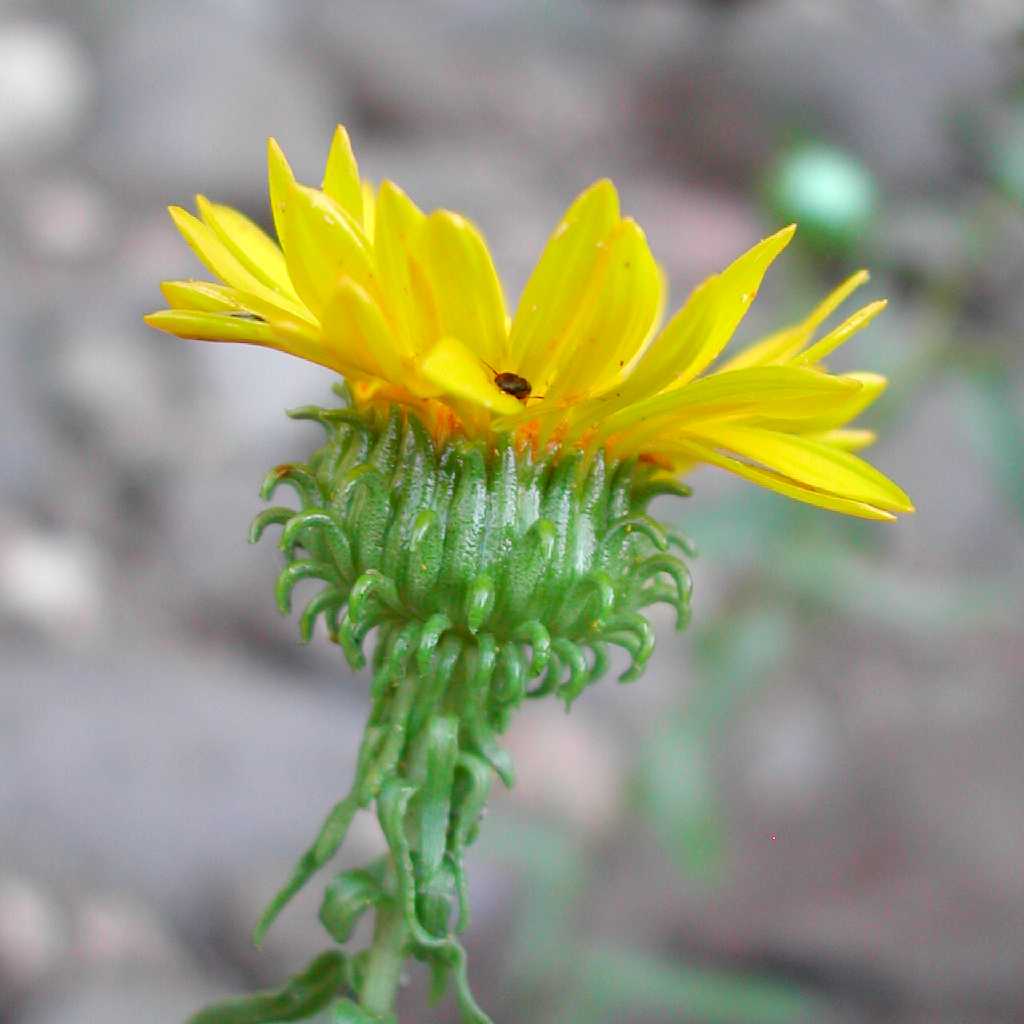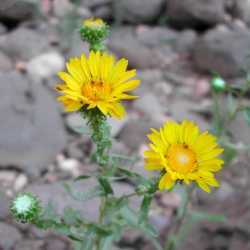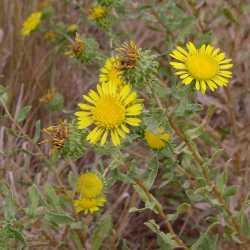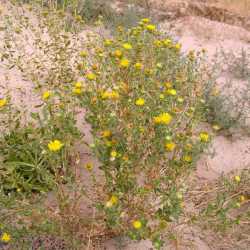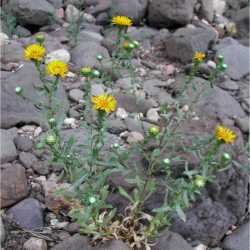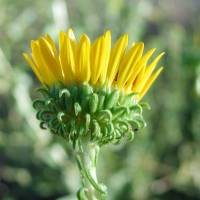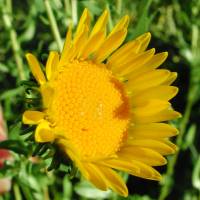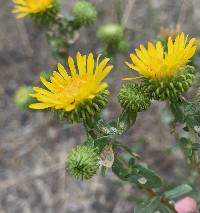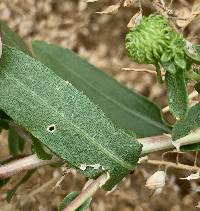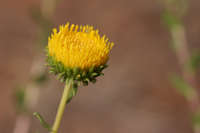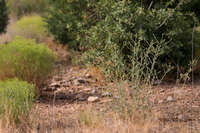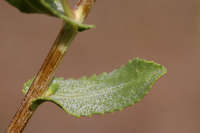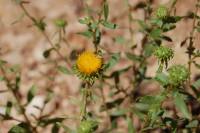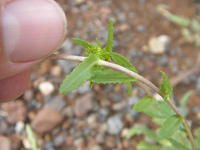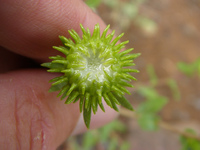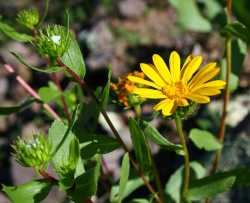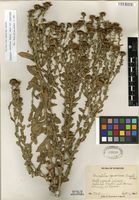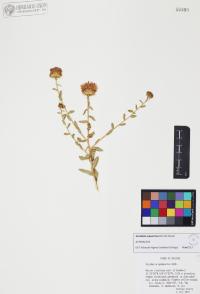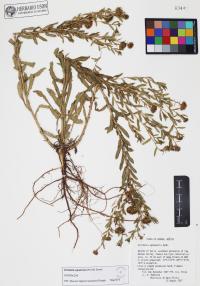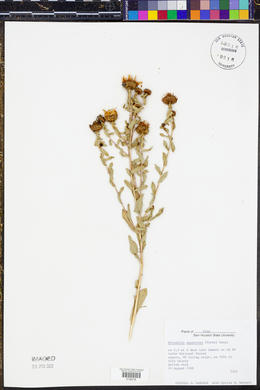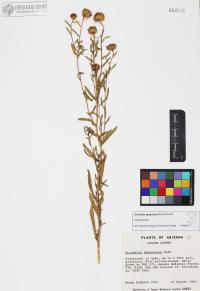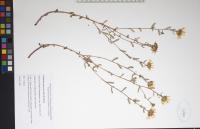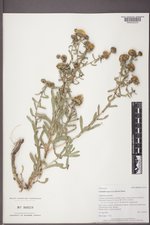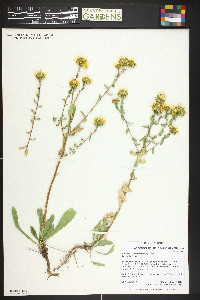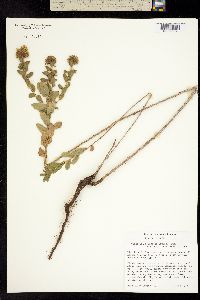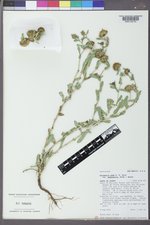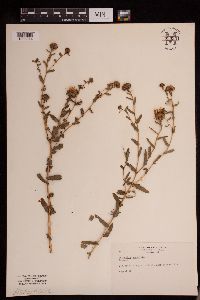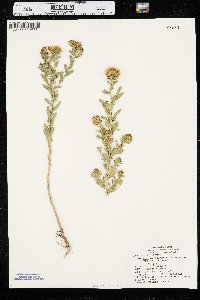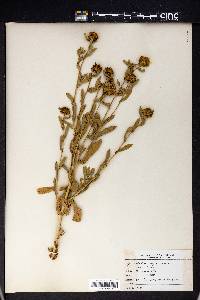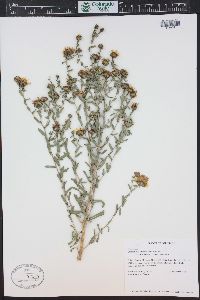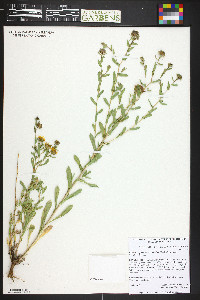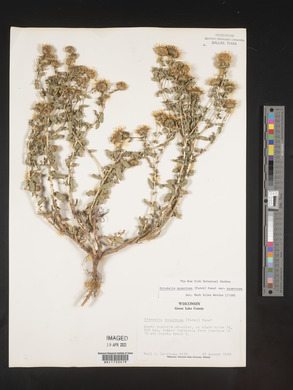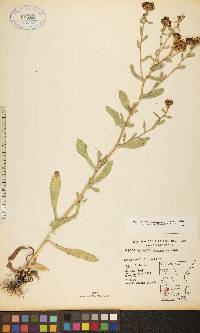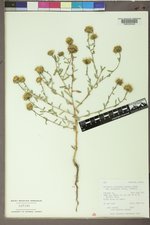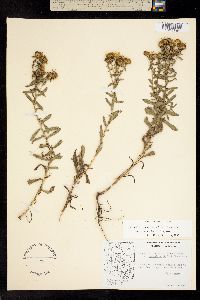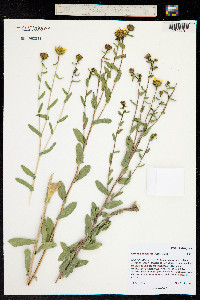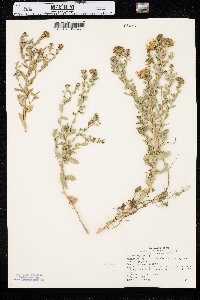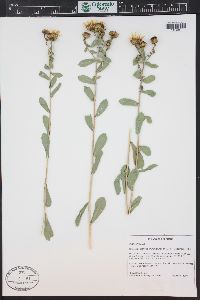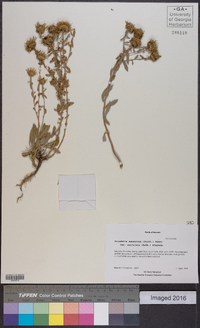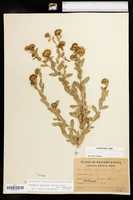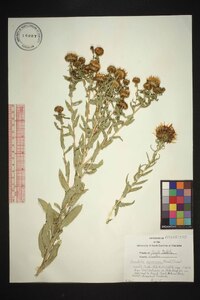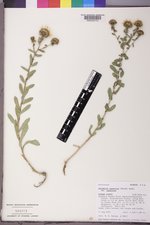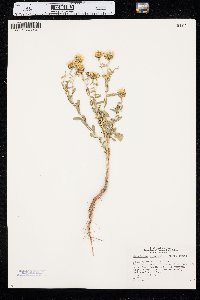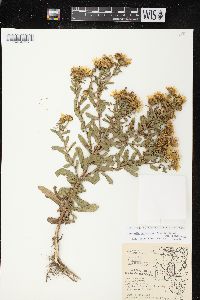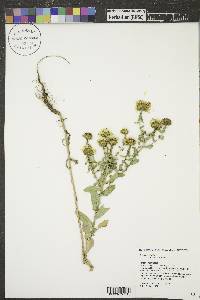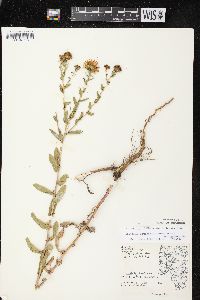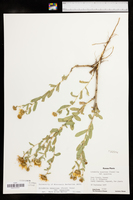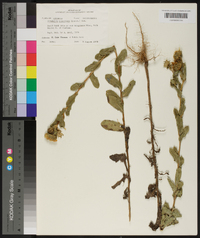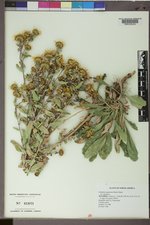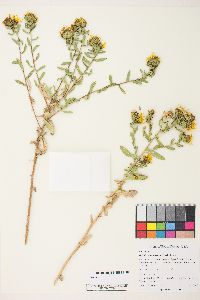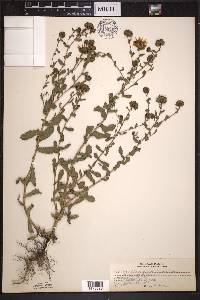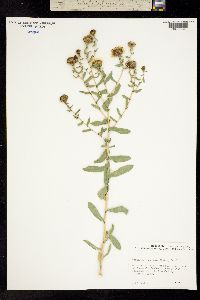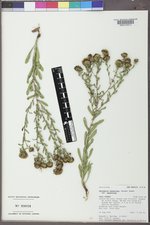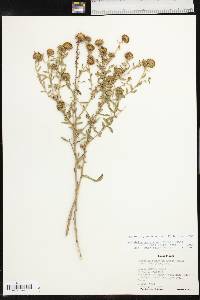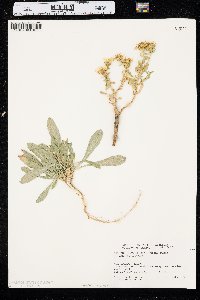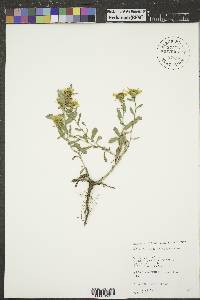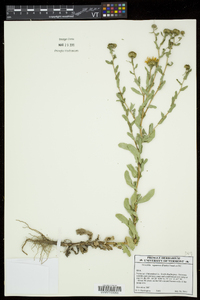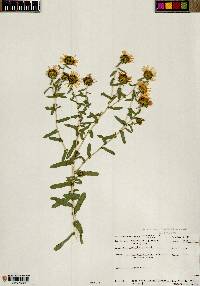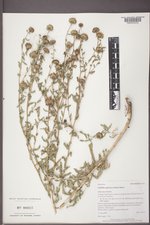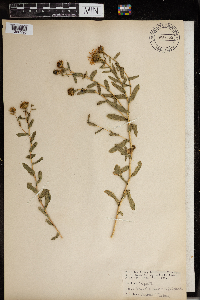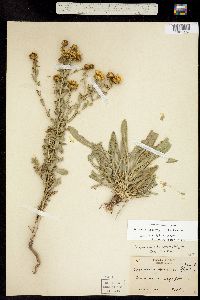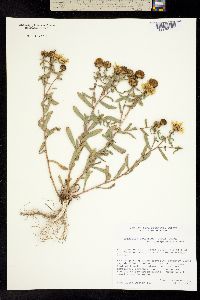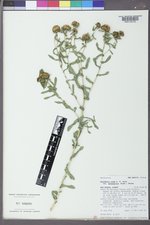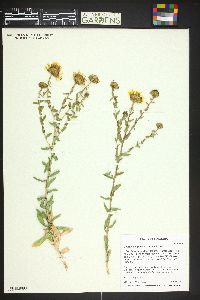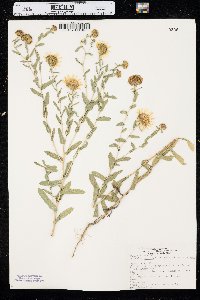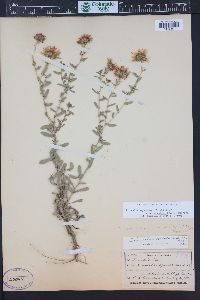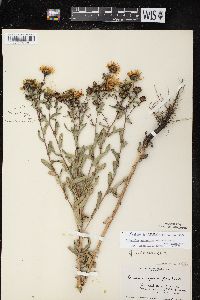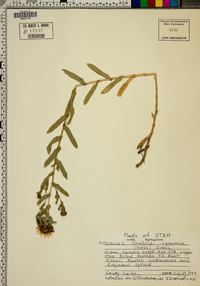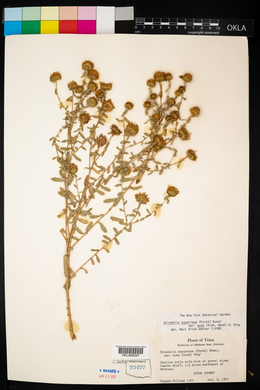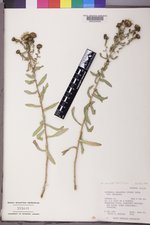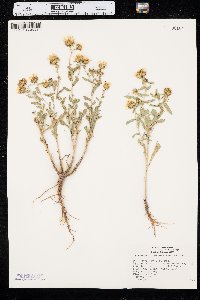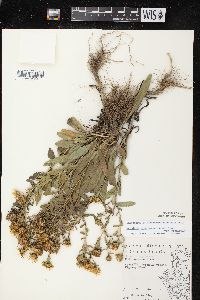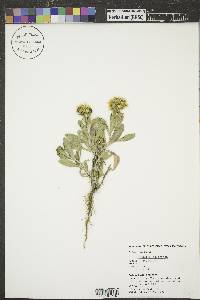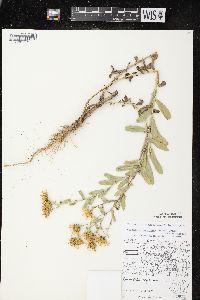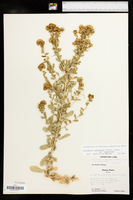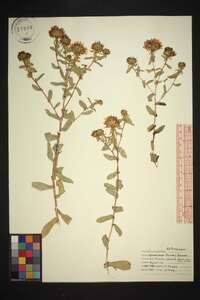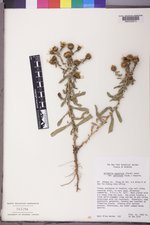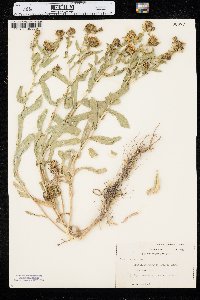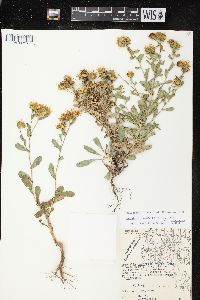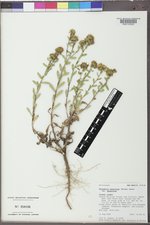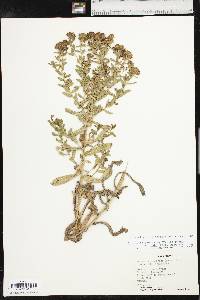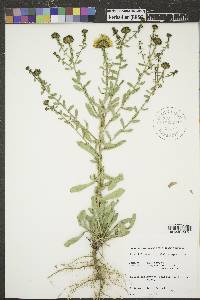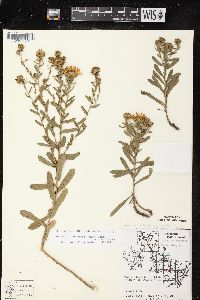Grindelia squarrosa
|
|
|
|
Family: Asteraceae
Curly-Cup Gumweed, more...curlytop gumweed, gumweed, rosinweed, tarweed
[Grindelia arguta, moreGrindelia squarrosa var. grandiflora] |
Biennials, perennials, or subshrubs (perhaps flowering first year, usually short-lived), (10-)40-100 cm. Stems erect, usually whitish or stramineous, sometimes reddish or grayish, glabrous. Cauline leaf blades oval, ovate, obovate, or oblong to spatulate, oblanceolate, lanceolate, or linear, (10-)15-70 mm, lengths 2-5(-10) times widths, bases ± clasping, margins usually crenate to serrate (teeth mostly 3-6+ per cm, rounded to obtuse, resin-tipped), rarely entire, apices obtuse to acute, faces glabrous, strongly gland-dotted. Heads usually in open to crowded, corymbiform arrays, rarely borne singly. Involucres broadly urceolate to hemispheric or globose, 6-11 × 8-20+ mm. Phyllaries in 5-6 series, reflexed to spreading or appressed, filiform or linear to lance-linear or lance-subulate, apices usually looped to hooked, sometimes recurved to nearly straight, subterete to subulate, moderately to strongly resinous. Ray florets 0 or (12-)24-36(-40); laminae 8-14 mm. Cypselae whitish, stramineous, brown, or gray, 1.5-4.5 mm, apices smooth, coronate, or knobby, faces smooth, striate, or ± furrowed; pappi of 2-3(-8), straight or contorted to curled, smooth or barbellulate to barbellate, subulate scales or setiform awns 2.5-5.5 mm, shorter than disc corollas. 2n = 12. Flowering Jul-Sep(-Oct). Disturbed sites, plains, hills, roadsides, along streams, sands, clays, and subalkaline soils; (10-)200-2900 m; Alta., B.C., Man., Ont., Que., Sask.; Ariz., Ark., Calif., Colo., Conn., Del., D.C., Idaho, Ill., Ind., Iowa, Kans., Ky., Maine, Md., Mass., Mich., Minn., Mo., Mont., Nebr., Nev., N.H., N.J., N.Mex., N.Y., N.Dak., Ohio, Okla., Oreg., Pa., R.I., S.Dak., Tex., Utah, Vt., Va., Wash., Wis., Wyo.; Mexico (Chihuahua); introduced in Asia (Ukraine). Grindelia squarrosa is probably native to the Great Plains and, perhaps, Rocky Mountain areas; it is widely introduced in other areas. Some plants are intermediate between it and G. hirsutula (i.e., between G. squarrosa and G. perennis, which has been treated as a variety of G. squarrosa). Plants of G. squarrosa with relatively narrow leaf blades (lengths mostly 5-8 times widths), mostly from the western part of the range of the species, have been treated as G. squarrosa var. serrulata. G. L. Nesom (1990i) and others have treated discoid plants included here in G. squarrosa as distinct (as G. aphanactis, G. nuda, and/or G. nuda vars. aphanactis and nuda); Nesom reported cypselae to be dimorphic in heads of radiate plants and monomorphic in discoid plants and noted that populations with discoid plants occur mostly south and west of populations with radiate plants. According to Nesom, plants of G. nuda with stems usually reddish (versus sometimes greenish), lengths of blades of mid-cauline leaves 4-10 (versus 1.5-4) times widths, and cypselae ± deeply furrowed (versus striate to shallowly furrowed) should be called G. nuda var. aphanactis. Hybrids between Grindelia squarrosa (nuda) and G. arizonica have been recorded from Arizona and New Mexico.
FNA 2006, Kearney and Peebles 1969, McDougall 1973, Allred and Ivey 2012, Heil et al 2013 Duration: Perennial Nativity: Native Lifeform: Forb/Herb General: Perennial or biennial herbs, occasionally subshrubs, to 1 m tall; stems 1 to several, erect, branching above, usually whitish or stramineous, sometimes reddish or grayish, the herbage gummy-resinous. Leaves: Alternate, the bases clasping the stem; blades oblong to oblanceolate, 3-7 mm long, the margins variously toothed and surfaces stipitate-glandular. Flowers: Flower heads usually radiate, arranged in corymbs or solitary; involucres campanulate, 7-9 mm high, strongly resinous, the bracts (phyllaries) overlapping in 5-6 series, the tips spreading or recurved; rays florets, if present, yellow, 25-40 per flower head, the laminae (ray petals) 7-15 mm long; disk flowers yellow. Fruits: Achenes short, thick, and compressed, 2-3 mm long, whitish, stramineous, brown, or gray; topped with a pappus of 2-3 (-8) straight awns, shorter than the disc corollas. Ecology: Found on sands, clays, and subalkaline soils, in disturbed sites, plains, hills, roadsides, along streams, and in forest and woodland understories, from 4,000-8,000 ft (1372-2438 m); flowers July-October Distribution: Widely occurring across the United States. Notes: Good indicators for this species are the sticky, resinous herbage; the yellow flower heads with phyllaries that have distinctive spreading or recurved tips; and the oblong, saw-toothed leaves. Note that this taxon can have radiate or discoid flower heads. G. nuda and G. aphinactis, which have discoid flower heads, were recently lumped into G. squarrosa (Strother and Wetter 2006). The Flora Neomexiacana (Allred and Ivey 2012) has upheld that decision so therefore we are treating all three taxa as G. squarrosa for this field guide. Heil et al's Four Corners Flora (2013) maintains G. nuda and G. aphinactis as sysnonymous with each other but separate from G. squarrosa and argues that in additon to the flower differences, the two groups also differ in achene morphology. Ethnobotany: Used to treat coughs, colds, and digestive ailments. Etymology: Grindelia is named for David Hieronymous Grindel (1776-1836), a German pharmacologist, physician and professor of botany at Riga, Estonia; squarrosa means curved at the ends, referring to the outward curving phyllary tips. Synonyms: Grindelia nuda var. aphanactis, Grindelia aphanactis, several others, see Tropicos Editor: SBuckley, 2010, Lcrumbacher, AHazelton 2017 Glabrous biennial or short-lived perennial 1-10 dm, branched at least above; lvs abundantly punctate; heads several or many, the disk 1-2 cm wide; invol bracts strongly resinous, imbricate in several series, the green tips (especially of the outer) squarrose-reflexed; rays 25-40, 7-15 mm, rarely absent; achenes 2-3 mm; pappus-awns 2-8, finely serrulate to subentire; 2n=12, 24. Open or waste places; Man. and Minn. to B.C., Nev., and Tex., and widely intr. elsewhere. July-Sept. The southwestern var. nuda (A. W. Wood) A. Gray, with discoid heads, is not a regular member of our flora. Three other vars., all radiate, occur with us: Gleason, Henry A. & Cronquist, Arthur J. 1991. Manual of vascular plants of northeastern United States and adjacent Canada. lxxv + 910 pp. ©The New York Botanical Garden. All rights reserved. Used by permission. From Flora of Indiana (1940) by Charles C. Deam This is a western species that is becoming established in Indiana as a weed in sandy fallow fields and waste places. Paul Standley writes that it is frequent in vacant lands in the vicinity of Whiting in Lake County. The variety [var. serrulata, which has linear-oblong leaves, 5-7 × longer than wide], like the [full] species, is becoming established in fallow fields, alfalfa fields, and waste places in northern Indiana. I have specimens from St. Joseph, Steuben, and Wells Counties. My specimens were determined by J. A. Steyermark who studied the genus. Both the species and variety are western plants that have been introduced and have established themselves. ...... Indiana Coefficient of Conservatism: C = null, non-native Wetland Indicator Status: FACU |
|
|
|

